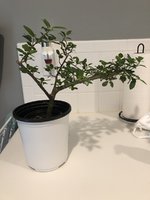geargarcon
Yamadori
So I’ve seen plenty of posts regarding how to decide what size bonsai pot.
I’ve also found write ups on nursery posts warning of overpotting and water draining out too quickly or under potting and restricting a plant during the development phase.
I got some trade gallon nursery pots that I think will be good for some of my plants but are probably too big for others. Is there a rule of thumb to follow for nursery pot size during development phase?
(yes this is living outside. Just brought in for easy picture. It is currently in a 4.5” wide by 5.25” deep nursery pot, but plan on slip potting into the white pot which is 6.3”x6.3”)
I’ve also found write ups on nursery posts warning of overpotting and water draining out too quickly or under potting and restricting a plant during the development phase.
I got some trade gallon nursery pots that I think will be good for some of my plants but are probably too big for others. Is there a rule of thumb to follow for nursery pot size during development phase?
(yes this is living outside. Just brought in for easy picture. It is currently in a 4.5” wide by 5.25” deep nursery pot, but plan on slip potting into the white pot which is 6.3”x6.3”)

